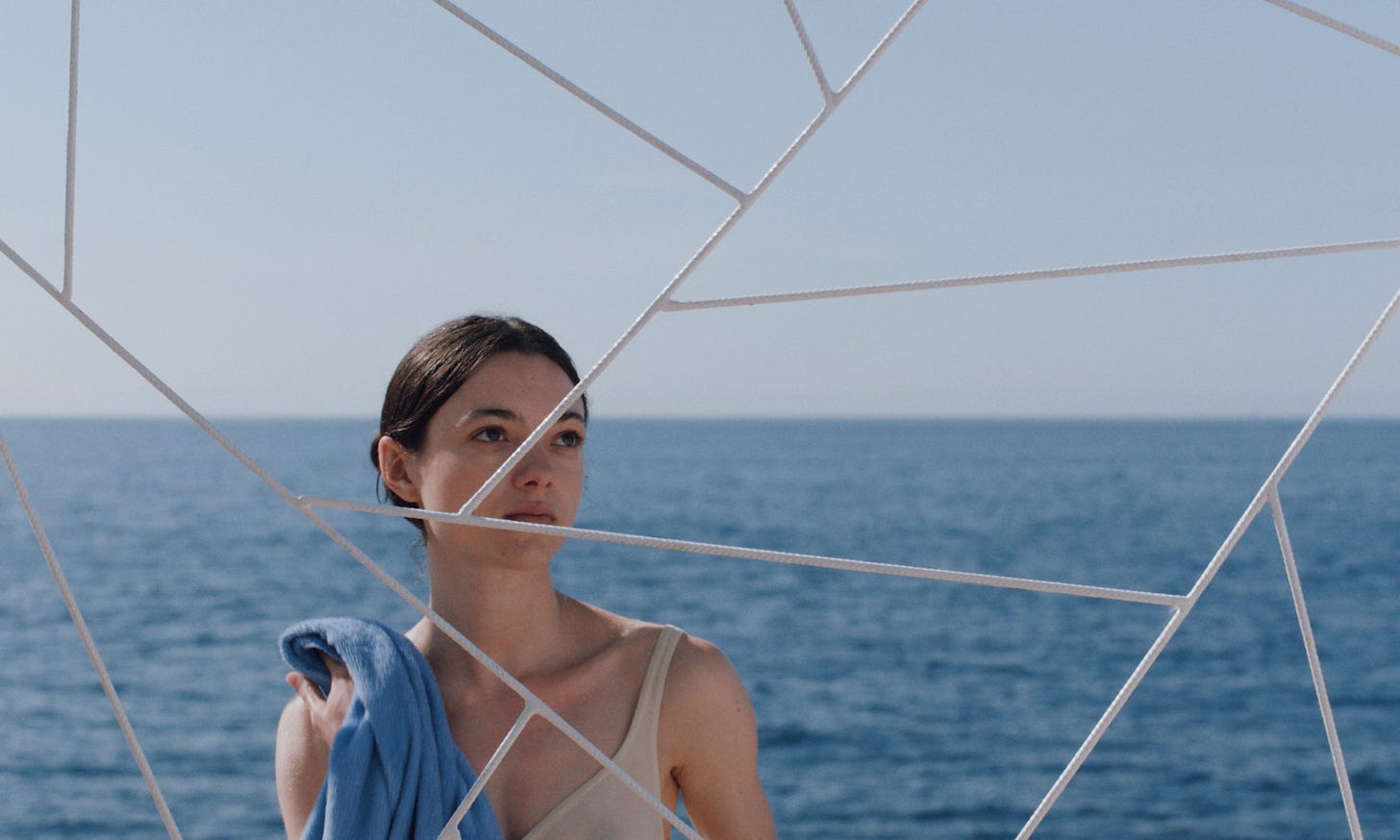The Presence of the Past
Reviews of “Caught By the Tides” and “Bonjour Tristesse.” Plus recommendations for where to drink baijiu cocktails.
There’s a bit of a lull at the multiplex this weekend, but arthouses have been feasting on last year’s film festival hits. (Have you seen The Shrouds yet?) Luminary director Jia Zhangke returns with Caught By the Tides, his first narrative feature since 2018, and critic and essayist Durga Chew-Bose sits in the director’s chair for the first time with a new adaptation of Bonjour Tristesse. I really dug the former film, didn’t care much for the latter, but then I read a great review that has me thinking that I’m just a lunk.
And: outdoor film season is upon us here in New York. I don’t always love these… you’re at the mercy of the weather (and mosquitos), the projection and sound aren’t ideal. But if it’s a movie you’ve seen before or a popcorn-muncher, it can work out. I had a blast watching Top Gun: Maverick in Prospect Park one year. You can bring your own drinks and snacks, and that’s a very nice bonus. Rooftop Films is screening two Hong Kong classics in Fort Greene Park: In the Mood for Love on May 14 and Comrades, Almost a Love Story on May 22. More will be announced from Rooftop in the coming weeks… The city also hosts a ton of screenings throughout the five boroughs, mainly aimed towards families. Schedule here.
Caught By the Tides
Opened May 9 in NY & LA, with limited expansion in subsequent weeks.
Those of us inhabiting the more irony-poisoned corners of the internet have come across memes about “The Chinese Century,” typically in sarcastic response to that nation’s increasing prominence on the world stage. To understand what a Chinese Century actually entails, particularly within its own borders, one can go beyond memes and watch the films of Jia Zhangke. The human effects of his country’s rapid growth is the Rolex brand ambassador’s perpetual subject, and it speaks to Jia’s talent that all of his films are about the same thing without becoming a stale retread. Maybe it's because his country is changing so quickly that there’s always fresh material to consider.
Caught By the Tides is perhaps Jia’s most self-reflexive work to date, as he repurposes unused footage from two of his older movies, Unknown Pleasures (2002) and Still Life (2006) and crafts a new narrative around them. That may sound imposing to someone new to the filmmaker’s work (or the passing off of reheated nachos), but it’s not necessary to have seen them beforehand1. The story is pretty simple: at the start of the 21st century, Qiao Qiao (longtime Jia muse Zhao Tao) falls in love with Guo Bin (Li Zhubin), her shady manager, but he leaves her in search of riches. Five years later, she unsuccessfully searches for him in a village far away from home. After assembling the first two parts in 2022, Jia wrote the film’s third (and best) act2. With China still reeling from the COVID pandemic, Qiao and Bin reunite in the city where they first met, but the two of them — and their country — have greatly changed.
Re-contextualizing the older material transforms then-present tense stories into retrospective visions, searing a contrast between the recent past and the China of today. The first and third segments were shot in Datong, a relatively small city in Shanxi Province. Twenty years separate the beginning and the end of this movie, and the city has since become unrecognizable, and not just because the fuzzy Betacam visuals have been upgraded to slick digital cinematography. Shopping malls and supermarkets have replaced the karaoke lounges and worker halls, but it’s the social distancing and masking regulations that make this city feel particularly alien. The second act, which pulls from Still Life, is set in a village that no longer exists: the area was flooded after the construction of the Three Gorges Dam. That earlier film was a document of a place on the verge of disappearance. In Caught By the Tides, it becomes a memorial to what is lost in the name of progress.
What holds the film’s three disparate segments together is the formidably constant presence of Zhao Tao, who almost exclusively acts in her husband’s films. She doesn’t speak throughout the entire movie, and spends most of the last act wearing a surgical mask, but she doesn’t need words—or the lower half of her face—to convey Qiao’s irrepressible determination. There’s a delightfully funny scene late in the film that turns discomforting in retrospect. Qiao is walking through a shopping mall when she encounters a talking robot that detects the sadness on her face. It awkwardly tries to console her by quoting Mother Teresa and Mark Twain platitudes about the essentiality of love and laughter. During a post-screening Q&A at the New York Film Festival, Jia remarked that westerners would ask him if this scene was science fiction, not knowing that these automatons are already everywhere in China. He also noted that the robot may have a deep well of knowledge, but it is not a replacement for human connection. The friendly machine will forget this encounter, its history overwritten like the villages flooded by a dam. But people will remember what was there.
Tasting Notes
In Ash Is Purest White, one of Jia Zhangke’s prior films, a group of gangsters mix a variety of different baijius into a punch bowl, calling it “The Five Lakes and the Four Seas.” I can’t recommend creating a sorghum spirit cuvée, especially with the very acquired taste of traditional varieties. Ming River Baijiu is a successful attempt to make a baijiu that better appeals to the western palate, with a smoother pour and less of that motor oil burn commonly associated with the likes of Moutai. Their baijiu has become an established part of some cocktail bars here in New York, including Chinato and Ye’s Apothecary, both on the Lower East Side. Across the river in Long Island City, 929 is a listening bar spinning Chinese pop that serves many baijiu-based drinks, but they eschew Ming River in favor of “the real thing.” All three bars are great, and I’m not just saying that because family members work at two of them.
Bonjour Tristesse
Opened May 2 in limited release. Coming to digital platforms June 13.
Like Caught By the Tides, the new film Bonjour Tristesse is set in the 21st century, but much of it feels a product of the 20th century of Françoise Sagan’s original novel. I blurbed about this film a few weeks ago:
I can’t be too mad about a couple hours spent watching hot people laze about the South of France. Durga Chew-Bose’s new adaptation of the mid-century French bestseller is very stylish and gorgeous to look at; “gorgeous gorgeous gowns” was the phrase I heard repeatedly at the post-screening reception. But psychological motivations are frustratingly communicated at a surface level. We don't see past the artifice that the characters (and the director?) have constructed for themselves. The shots are beautifully constructed, but what are they in service of beyond Call Me By Your Name vibes? Buttered toast figures prominently, and oddly enough, food is one of the only elements that goes beyond mere aesthetics to convey insights into the characters, however facile. Witness Chloë Sevigny’s character intricately slicing a pineapple: she strives for cleanliness and proper presentation, but you can’t avoid getting a little messy.
I was pretty lukewarm on it! But Elissa Suh’s excellently-written review, published in her newsletter Moviepudding, was so persuasive on the film’s merits that now I think I’m just not seeing it properly:3
It’s easy to write off this vivid, ravishing film as a Eurocore romanticization of sunlight, sailboats, and effortless living. But look a little closer and find sorrow sewn into its seams. Chew-Bose’s work has been compelled by the tactile motions of memory, recollections without nostalgia, and her filmmaking debut follows suit. She has an instinctive fluency in image-making, organizing the film around what is unsaid—the restless triangulation of the women’s interactions, tuning it to their faint frequencies (each performer reaching for pensive depths), as if adjusting a dial to find their exact wavelength. And in that moment, they are revealed in the tender intimacy of their unspoken world; how they eat their breakfast, how they curl up into a chair, if they use a chair at all.
Go read the whole piece, if you’d like, which includes an interview with the film’s director:
Tasting Notes: buttered toast (I should write a guide to my favorite butters), an immaculately sliced pineapple, Aperol spritzes aplenty. Eat and drink these by the pool; summer’s coming.
Been meaning to go through Jia Zhangke’s filmography, but the pleasures of Unknown Pleasures remain unknown to me. Still Life is very good though!
This is not the first of Jia’s films to have been made over a long period of time. His prior two narrative features, Mountains May Depart and Ash Is Purest White, were also filmed over the course of decades and incorporate material shot for earlier projects, but not to the scale as in Caught By the Tides.
But we both agree that Luca Guadagnino’s Queer was “hollow.”










